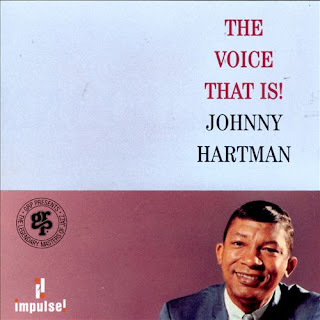Fortunately, the success of John Coltrane and Johnny Hartman prompted Impulse to record Hartman more extensively, and The Voice That Is, cut at Rudy Van Gelder's studio in September 1964, is actually his third outing for the label. The LP was the product of two different sessions, both produced by Bob Thiele. The first one took place on September 22 and finds Hartman accompanied by Hank Jones on piano, Barry Galbraith on guitar, Richard Davis on bass, and Osie Johnson on drums. The setting here is rather similar to what we can hear on his previous album, I Just Dropped By to Say Hello, and the songs are mostly intimate ballads ("My Ship," "These Foolish Things," "It Never Entered My Mind") that Hartman handles with ease and elegance. There's a mid-tempo number, "The More I See You," that proves Hartman can swing when he wants to, and a lovely version of Bill Evans's "Waltz for Debby" (Gene Lees's beautiful lyrics sound tailor-made for Hartman) that is one of the highlights of the album and makes me wish that the vocalist had done an LP with Evans, like Tony Bennett and Monica Zetterlund did. The same quartet appears again on the second session, held on September 24, except for the fact that Bob Hammer, who handles the arrangements as well, replaces Hank Jones on piano. Also, the lineup is augmented with Dick Hafer on reeds, Phil Kraus on marimba, Howard Collins on guitar, and Willie Rodriguez on percussion, and so the rhythms become more unusually exotic, as on the catchy "The Day the World Stopped Turning," which features a beautiful flute solo by Hafer, and Henry Mancini's lesser-known "A Slow Hot Wind," whose very charming melody is subtly punctuated by Kraus's marimba. On this session Hartman took a stab at more contemporary songs, such as Ennio Morricone's "Funny World," Bart Howard's "Let Me Love You," and "Sunrise, Sunset," from Fiddler on the Roof, which closes the album. Frank Loesser's "Joey. Joey, Joey" is another good example of a tune that doesn't usually turn up on vocal jazz albums (Sammy Davis, Jr. did it as a duet with Brazilian guitarist Laurindo Almeida, for instance) but then The Voice That Is simply isn't a typical vocal jazz record. Hartman made a few more recordings in the 1960s, '70s, and '80s, before his passing in 1983, including some excellent Coltrane-inspired sessions in Japan, yet he sadly never achieved the kind of recognition that his talent should have warranted. Luckily, we still have his albums, and The Voice That Is remains one of his freshest and most satisfying efforts.
Recommended Reading
The only book-length biography of Johnny Hartman currently available is Gregg Akkerman's excellent The Last Balladeer: The Johnny Hartman Story (Scarecrow Press, 2012). You may find it here.
Johnny Hartman Online Discography
Mr. Akkerman and my friend Noal Cohen collaborated on a very thorough Johnny Hartman discography, which you may find here.



No comments:
Post a Comment